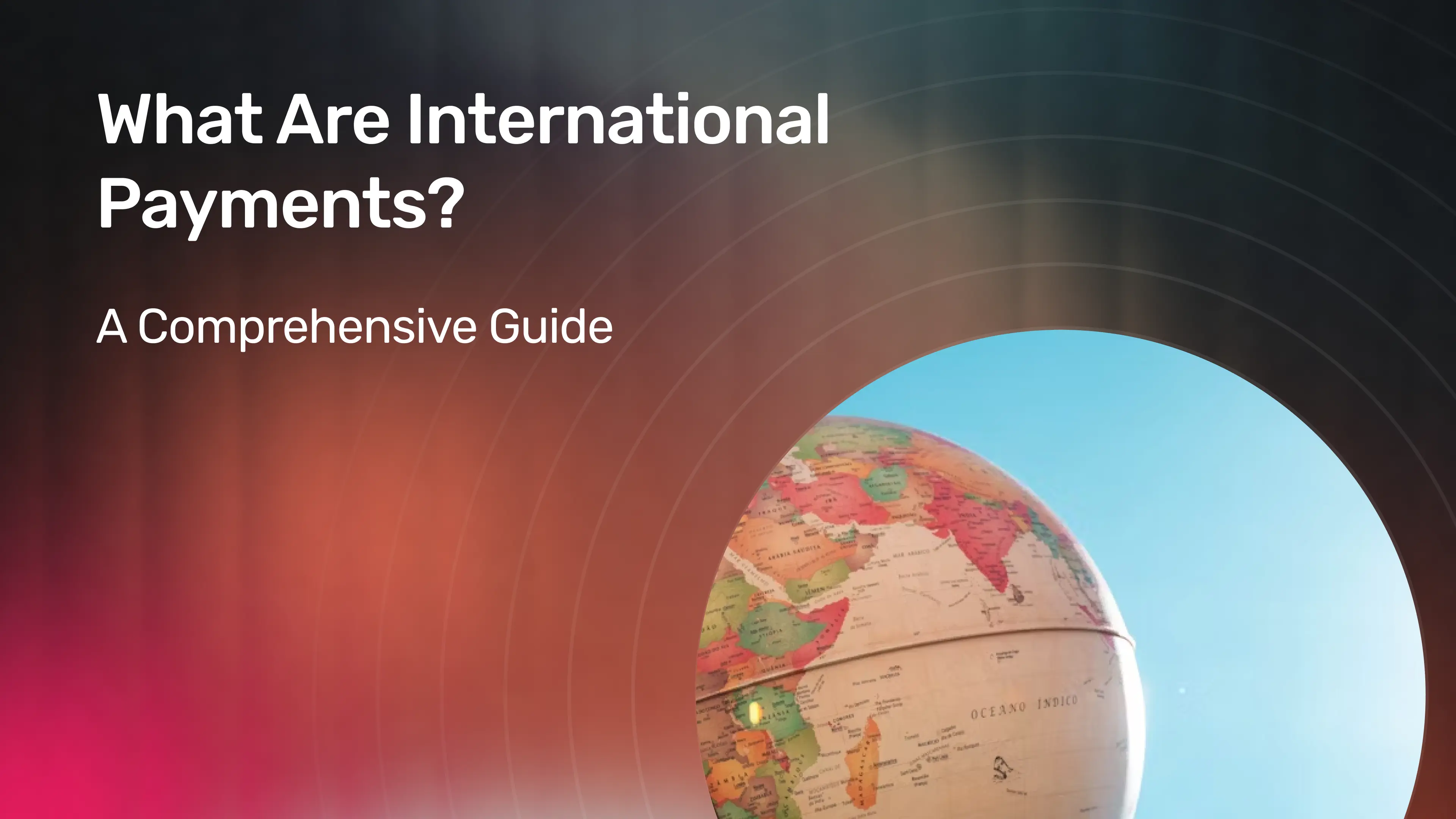What Are International Payments? A Comprehensive Guide
Whether you freelance for global clients, work remotely for an international company, or own a business that employs worldwide talent, we’re sure that international payments are part of your job.
However, when sending and receiving money across borders, things can get a little bit tricky. Hidden fees, currency conversions, taxes, and compliance with international laws - there are indeed many things that need to be considered. But worry not - in this guide, we’ll break down everything you need to know regarding international payments. Keep reading for valuable insights!

What are international payments?
In simple terms, international payments are transactions where money is sent from one country to another. It includes the process of moving money between different countries to allow people like freelancers, contractors, and business owners to pay and receive money for goods, services, and international employees payments.
For example, let’s say you run a small business in the US, and you’ve hired a freelance graphic designer from Norway to create a logo for your brand. Once the designer finishes creating the logo, you need to pay them for their service, and since you both live in different countries, you have to make an international payment.
For this purpose, you’re most likely going to use a digital payment platform, like Native Teams, to send the amount from your US bank account to the designer’s bank account in Norway. Since this amount of money is transferred across borders, it’s considered an international payment.
Why are international payments important?
International payments are the foundation of working remotely across the world. They make it possible for businesses to trade, freelancers to get paid, and even families to support their loved ones living abroad.
Without international payments, businesses wouldn’t be able to pay suppliers in other countries or sell their products to international customers, which would create a huge barrier to the global economy.
For freelancers and remote workers, global payments ensure that they get paid for their work, regardless of the location of their clients. For companies, on the other hand, global payments make it possible to hire remote workers, purchase the best material, and get the best services from all around the world.
Simply put, international payments keep the global economy moving and make it easier for people and businesses to work together no matter their distance.

How do international payments work?
As we already established, international payments move money from one country to another using bank transfers or payment platforms. This process includes a few steps to ensure that the money gets to the right destination safely and in the right currency.
1. Initiating the payment
The sender of the money is the initiator of the international payment, and the process starts by providing the payment details, including the recipient’s name, bank account number, and country. This is usually done through banks, payment platforms, and sometimes specialised online payment services.
2. Currency conversion
If the payment involves two different currencies, the money is converted from the sender’s currency to the recipient’s. For example, dollars might be exchanged for euros, often using an exchange rate set by the bank or the platform handling the transfer.
3. Payment processing
Once the payment is sent, it goes through a processing system that moves the money between the sender’s bank or service and the recipient’s. This step sometimes involves intermediaries or clearinghouses to handle the transfer.
4. Receiving the payment
Finally, the recipient receives the payment in their local bank account or their digital wallet. Depending on the method used, this can happen instantly or take a few days. Once received, the money is ready to use.

Key factors affecting international payment costs
The costs of sending money across borders depend on a few factors that can add up quickly if you’re not careful. Understanding these costs can help you choose the best way to send and receive international payments without spending more money than you need to. Here are some of the factors:
Exchange rates
Exchange rates determine how much one currency is worth compared to another, and they can widely affect the final amount received. In addition to this, many banks and payment providers add a markup to the exchange rate, which is a hidden fee that many don’t consider.
For example, if the actual market exchange rate of 1 USD is 0.90 EUR, the service provider might give you 0.88 EUR per dollar instead and keep the difference as profit. Even small changes in the exchange rate or not being aware of currency risks can make a big difference, especially for larger transactions. So, it’s always a good idea to compare rates before sending money.
Transfer and bank fees
Fees are one of the most obvious costs of international payments, and they come in many forms. For example, some banks may charge a flat fee for initiating a transfer, and the recipient’s bank might charge another fee for receiving it. If you’re using a digital platform, you can also get charged a percentage of the total amount, which can add up for larger transfers.
In addition to this, there could also be hidden fees like intermediary bank charges if the payment goes through multiple banks before reaching the recipient. So, always read the fine print to know what you’re paying for and potentially avoid hidden costs.
Transfer time
The time the payment needs to arrive at its destination can also affect the transfer cost.
For instance, faster transfers that are received instantly or on the same day often come with higher fees because they require priority processing. On the other hand, standard transfers, which may take a few days, are usually cheaper but can be less convenient if the payment is urgent.
So, making a balance between the cost and the speed of transfer is among the most important factors in choosing the best option for your needs.
Security
When transferring money internationally, security is non-negotiable. Payment providers nowadays invest in encryption, fraud detection systems, and secure processing networks to protect your funds and personal information when processing a transfer.
However, while the most reliable providers prioritise security, many of them often charge higher fees to cover these advanced protections. So, sometimes, it’s worth paying a bit more for peace of mind, especially for large and sensitive transactions.
Other factors to consider
Among the factors that add up to the transaction costs are the regulations of the countries involved. For example, some countries might impose taxes or require additional documentation to make a cross-border payment, which can add to the overall expense.
The method of payment, whether it’s a bank transfer, digital wallet, or cryptocurrency, can also influence the fees. Hence, exploring all your options can help you find the best balance between the cost, speed, reliability, and convenience of transfer.

Types of international payment methods
When it comes to sending money across borders, you have plenty of options to choose from. Each of these options comes with its own pros and cons, and the right choice depends on what’s most important to you - cost, speed, or ease of use. Below, we explore the different types of international payment methods in more detail.
Bank wire transfers
Bank wire transfers are one of the oldest and most widely used methods for international payments. They allow you to send money directly from your bank account to someone else’s, no matter where they’re located. They are secure and work well for large sums of money, which makes them a preferred option for many businesses and individuals.
However, bank wire transfers can be costly, as banks often charge a flat fee for sending money. If the transfer includes intermediary banks to pass the funds through different banking systems, you may be charged additional fees along the way. Besides the flat bank fee and intermediary fees, some banks also charge exchange rate markups that make this option even more expensive.
Moreover, on top of the expenses for processing a bank transfer, this method can take several days to complete.
Digital payment platforms
Digital payment platforms, like Native Teams, are a popular choice for sending international payments. They’re very easy to use, offer competitive exchange rates, and are often quicker than international bank transfers. On top of this, they’re very appealing to freelancers, remote workers, and small businesses, as they speed up the payment process and don’t require complicated bank details.
However, while some platforms allow sending money globally within minutes, the fees can be high for certain transactions. Some, on the other hand, may offer transparent pricing and excellent exchange rates but might take longer to process the payment, depending on the destination. So, it’s essential to make a good assessment of the available options before making your ultimate choice.
Crypto payments
Cryptocurrencies, such as Bitcoin and Ethereum, are becoming a very popular alternative for sending money internationally. They operate on blockchain technology, which is convenient as it eliminates the need for intermediaries and makes transactions faster and, in some cases, even cheaper.
However, crypto payments are not riskless. The value of cryptocurrencies can fluctuate, meaning that the amount sent may not hold the same value when received. In addition to this, crypto payments are not yet widely accepted, and the lack of regulations can deter some people from using them.
Money transfer services
Money transfer services like Western Union, MoneyGram and RemitBee specialise in sending money quickly to almost any part of the world. These services can be particularly useful if the recipient doesn’t have a bank account, as they can quickly and conveniently pick up the transferred amount from a local agent.
But while these services are very fast, with some transfers being available within minutes, they often come with high fees and less favourable exchange rates. Hence, they might be a good choice for small and urgent transactions but less ideal for large sums and frequent use.
International checks
Though not as common today, international checks are still used in certain situations, especially for formal and large transactions. This type of method involves sending a physical check to the recipient, who can then deposit the amount into their account.
Processing international checks is slow and can take weeks to clear, and banks may charge significantly high fees to process the check. Hence, this method is best suited for cases where digital transfers aren’t possible or when a paper trail is required for legal or business reasons.

How can Native Teams help you send (and receive) international payments?
Native Teams is an all-in-one platform that helps freelancers, remote workers, and business owners initiate global payments and get paid across borders. Our all-inclusive payment solution will help you sort out all of your payment needs with a set of tools and features that are conveniently packed in one place.
- Client invoicing - our global client invoicing tool will help you bill your clients anywhere in the world without setting up your own company.
- Payment requests - through the Native Teams platform, you can also send one-time or recurring payment requests to automate the payment process and collect your earnings timely.
- Multi-currency wallet - once you sign up with the Native Teams platform, you get access to a wallet that supports dozens of currencies, so you can manage your funds without the high conversion costs.
- Dedicated IBAN - your Native Teams account comes with a dedicated IBAN, so you can send and accept international payments and manage your transactions in the currency of your choice.
- Native Teams card - our users get their own Native Teams cards for convenient in-store or online payments anywhere in the world.
Summing up
International payments might seem complicated at first, but they’re an essential part of our global world of work. Whether you’re a freelancer who works for clients abroad or a business expanding into new markets, understanding how these international transactions work can ease your job and save you a lot of time and money.
However, not all payment solutions are created equal, and choosing the right one means understanding your options, researching providers, and considering the speed, cost, and convenience. By carefully evaluating your needs and factors that impact the payment cost, you’ll be able to make a smart decision and keep your finances in control.
